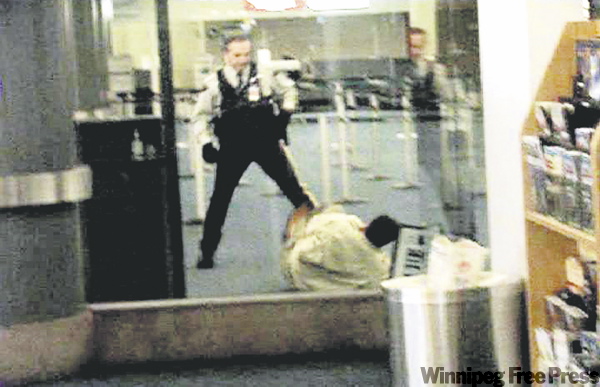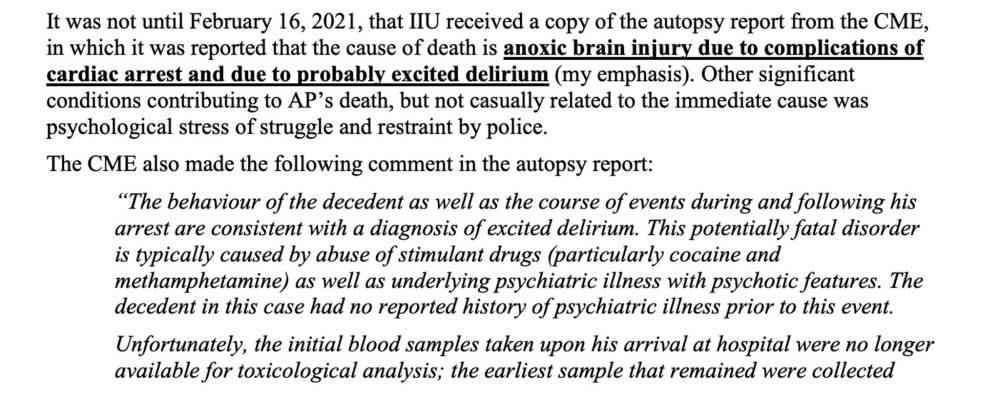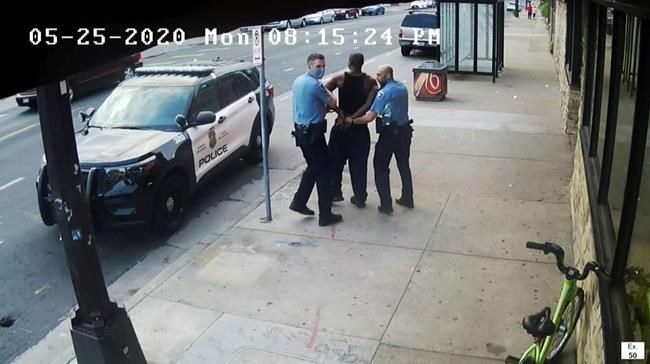Pseudoscientific charade Critics allege the widely debunked diagnosis of ‘excited delirium’ is a convenient concept that offers a way to mask a more accurate cause of death in custody — asphyxia due to prone restraint
Read this article for free:
or
Already have an account? Log in here »
To continue reading, please subscribe:
Monthly Digital Subscription
$0 for the first 4 weeks*
- Enjoy unlimited reading on winnipegfreepress.com
- Read the E-Edition, our digital replica newspaper
- Access News Break, our award-winning app
- Play interactive puzzles
*No charge for 4 weeks then price increases to the regular rate of $19.00 plus GST every four weeks. Offer available to new and qualified returning subscribers only. Cancel any time.
Monthly Digital Subscription
$4.75/week*
- Enjoy unlimited reading on winnipegfreepress.com
- Read the E-Edition, our digital replica newspaper
- Access News Break, our award-winning app
- Play interactive puzzles
*Billed as $19 plus GST every four weeks. Cancel any time.
To continue reading, please subscribe:
Add Free Press access to your Brandon Sun subscription for only an additional
$1 for the first 4 weeks*
*Your next subscription payment will increase by $1.00 and you will be charged $16.99 plus GST for four weeks. After four weeks, your payment will increase to $23.99 plus GST every four weeks.
Read unlimited articles for free today:
or
Already have an account? Log in here »
Hey there, time traveller!
This article was published 22/12/2023 (702 days ago), so information in it may no longer be current.
Just before 1 a.m. on Aug. 2, 2019, two Winnipeg police officers arrived at an Elmwood home. Within minutes, a man would be handcuffed face-down on a sidewalk, his ankles shackled, struggling to breathe.
Two days later, that man, Viengxay Chommany, 42, would be dead.
Details of what happened that night come from two documents — a report from the Independent Investigation Unit of Manitoba, the province’s police watchdog, that cleared the officers of criminal wrongdoing, though police refused to be interviewed and only provided their notes, and a civil lawsuit filed in 2021 by Chommany’s family.

According to the two officers, they broke down the front door when they saw Chommany assaulting his wife through a window. According to the lawsuit, Chommany’s wife says no such assault happened — not that night, not ever. And that she only called police as her husband, who lived with bipolar disorder and schizophrenia, was off his medications and acting strangely.
When police crashed through the door, Chommany’s wife says the officers began aggressively yelling at him. Chommany asked the officers if their guns were real. Suddenly, he ran out the door, shoeless, with officers in pursuit.
Chommany paused and “assumed a fighting stance,” so the first officer Tasered him, according to the IIU report. The officers then pulled him to the ground, where they said the 5-foot-4, 180-pound man was struggling, kicking and grabbing at them.
The first officer said he punched or kneed Chommany four times in the thigh or shoulder. The second said he punched him in the face roughly five times, then Tasered him, before managing to get handcuffs on. A third officer arrived and shackled Chommany’s legs.
When his breathing grew shallow, they said they then turned him onto his side, until medical assistance showed up, though two firefighter-paramedics would later tell IIU investigators Chommany was still face-down when they arrived.
A Manitoba pathologist would later determine Chommany died from complications of “Anoxic Brain Injury” due to “Probable Arrhythmia” due to “Excited Delirium.” The syndrome known as excited delirium is said to cause a wide array of symptoms: from an inability to feel pain, to superhuman strength and excessive sweating, to an aversion to shiny objects and talking in gibberish.

The problem, however, is that the syndrome would soon be thoroughly debunked.
Today, excited delirium is widely recognized as pseudoscientific and not seen as a legitimate medical diagnosis. It’s never been included in medical diagnostic manuals like the DSM-5 or ICD-10. It is typically only referenced in police-involved deaths or other in-custody deaths and its spread is linked to the company that manufactures Tasers. It’s also been identified as being a proxy for a different, more accurate cause of death: asphyxia from prone restraint.
Since 2020, at least five major medical association in the United States have publicly opposed the use of the term as a diagnosis or a cause of death. Earlier this year, California banned the term from death certificates, police training and civil litigation. Colorado is considering a similar step.
While the medical consensus rejecting excited delirium has only fully crystallized since 2020, red flags have existed in Canada for at least 15 years. In 2008, an independent review for the RCMP found excited delirium should be considered “folk knowledge” when cited by police. And by 2010, two judges, on opposite sides of the country, raised concerns about the so-called syndrome.
In a landmark report into the death of Polish immigrant Robert Dziekanski, who died in 2007 after being Tasered multiple times by an RCMP officer at a Vancouver airport, the late Justice Thomas Braidwood determined the term excited delirium is essentially meaningless — providing no more insight into a person’s cause of death than saying, “sudden death during a car accident.”
“It is not helpful to blame resulting deaths on ‘excited delirium,’ since this conveniently avoids having to examine the underlying medical condition or conditions that actually caused death, let alone examining whether use of the conducted energy weapon and/or subsequent measures to physically restrain the subject contributed to those causes of death,” Braidwood wrote.

That same year, Nova Scotia Judge Anne Derrick found the 2007 death of Howard Hyde — a mentally ill man who’d been restrained by jail guards, a day after being Tasered by Halifax police officers — was not a result of excited delirium, but rather, the struggle and restraint.
“Excited delirium, if it exists at all, is irrelevant in this case, a red herring,” wrote Derrick.
Both judges recommended Tasers not be used on emotionally disturbed people.
The term could have fallen out of favour. But it didn’t. At least four people are said to have died from the so-called syndrome in Manitoba in the years since: Christopher Chastellaine in 2014; Patrick Gagnon in 2018; Aaron Ross in 2019; and, earlier that year, Chommany.
Each of the men died following altercations with Winnipeg police in which they were handcuffed and restrained face-down; three had their legs bound by a restraint known as an RIPP Hobble or by ankle shackles.
In Gagnon’s case, he was restrained by several officers after he’d been found, distraught, climbing on a train in an industrial park; two of his family members later told IIU investigators his nose was bleeding and face bruised as a result.
Meanwhile, officers encountered Ross, who’d been seen acting bizarrely near the Assiniboine River, as a the result of a well-being call. The officers said they restrained Ross to stop him from going into the river. He stopped breathing and was given CPR; after being revived, he continued fighting, officers said, so one put a RIPP Hobble on him.

In an email exchange with the Free Press, Manitoba’s chief medical examiner, Dr. John Younes, indicated his office will avoid using the terms excited or agitated delirium going forward. Yet asked whether he will review the term’s application in prior cases, Younes defended its use and confirmed he has no plans to do so. (See the Free Press‘s full correspondence with Younes, here.)
“In the three cases you mentioned, I stand by the causes of death provided, as the underlying cause of the excited delirium is made clear, or at least discussed, in the autopsy reports,” Younes wrote, referring to Ross, Chommany and Gagnon.
The origin story of excited delirium begins in the early 1980s in Miami, Fla., with a forensic pathologist named Dr. Charles Wetli. He and a colleague came up with a theory that it was responsible for the deaths of several people with non-lethal amounts of cocaine in their blood.
The factor not addressed was that the people had been restrained and held down, said Joanna Naples-Mitchell, a human rights lawyer who co-authored a 2022 report on excited delirium by the New York-based non-profit Physicians for Human Rights, which determined excited delirium is not a “valid, independent medical or psychiatric diagnosis.”
A few years later, Wetli expanded his theory to explain the deaths of more than 17 Black women, saying excited delirium — caused by sexual ecstasy and cocaine use — led to their demise.
It fell apart when other investigators and families of the women pushed back, saying the cases looked like murders. Another pathologist would later reclassify their deaths as homicides, finding signs of strangulation, and most of their deaths were linked to a serial killer, Naples-Mitchell said.
Instead of fading away, excited delirium gained traction, leading Physicians for Human Rights to ask: how did one theory become a concept widely applied to in-custody deaths across the U.S.?
What they discovered was a select number of researchers, many funded by the company that manufactures Tasers or by law enforcement, who served as expert witnesses and published “very self-referential journal articles” about excited delirium, Naples-Mitchell said.
That included an influential white paper, published in 2009 by the College of Emergency Physicians, that appeared to be an authoritative account.

Less clear, was that a number of the paper’s authors were linked to Axon Enterprise, Inc., the U.S. company that makes Tasers, and that the company actively promoted the concept of excited delirium to police chiefs and medical examiners at conferences, as the PHR report detailed.
Earlier this year, the American College of Emergency Physicians formally withdrew its approval of the white paper. The association said the term was “outdated,” not aligned with current research and should no longer be referred to.
Naples-Mitchell called the withdrawal a “a huge sea change.”
“It makes it very hard for testimony on excited delirium to be admitted in court — because there’s no longer any medical association to point to, to say, ‘this is a valid concept,’” she added.
Dr. Michele Heisler, the medical director of Physicians for Human Rights and a professor of internal medicine and public health at the University of Michigan, said “delirium” — on its own — is a valid medical concept. But it’s a symptom, not a diagnosis, nor a cause of death. It’s a sign of a more significant issue, such as sepsis, lack of oxygen or the adverse result of a medication, she said.
“When first responders are trained that this is this scary diagnosis, I think it’s under-pinned excessive use of force,’” she said, instead of taking steps to de-escalate.
Her concern goes beyond the term itself, to the concept.
“A lot of the symptoms are actually quite racist tropes, like being impervious to pain, having ‘superhuman strength,’” she said.
As an example, at the murder trial of the former Minneapolis police officer who kneeled on the neck of George Floyd, a 46-year-old Black man, for almost 10 minutes, his lawyers unsuccessfully invoked the concept of excited delirium as a defence for his behaviour.

Currently, it appears none of Canada’s major medical associations have taken a public position on excited delirium, according to a Free Press review.
Dr. Michael Howlett, the president of the Canadian Association of Emergency Physicians, confirmed the body has no official position, but said the term probably shouldn’t be used — whether in medicine or beyond.
“It’s a vague, sort of catch-all type of a term, it doesn’t speak to cause, it doesn’t speak to the underlying pathology,” he told the Free Press.
“It wasn’t taught to me in medical school.”

A new wave of questions over excited delirium arose earlier this year during the coroner’s inquest into the death of Myles Gray. Gray was severely beaten by Vancouver police officers in 2015 and the syndrome was initially raised as a possible cause of death.
But at the inquest, according to reporting by The Tyee, the forensic pathologist who did Gray’s autopsy reversed course, testifying he no longer believes excited delirium is a useful description. The inquest jury determined Gray’s death was a homicide.
In Manitoba, excited delirium has been raised during an ongoing inquest into the deaths of five men: Patrick Gagnon, Michael Bagot, Matthew Fosseneuve, Randy Cochrane and Sean Thompson. Each died following altercations with Winnipeg police in 2018 or 2019. Though excited delirium was only listed as a cause of death for Gagnon, it was referenced by officers in some of the other cases.

During testimony last month, several officers said the service no longer refers to “excited delirium;” instead uses the term “agitated chaotic event,” or ACE. Officers testified repeatedly about the need to gain control of subjects using handcuffs and restraint — and to do so quickly.
It was not clear from testimony if the service has also changed its training — which, as of 2019, suggested officers Taser people thought to be suffering from excited delirium.
The police service initially declined to answer questions about its training and procedures surrounding excited delirium, citing the ongoing inquest, however a spokesperson later provided a brief emailed statement.

Const. Dani McKinnon said the force began using the new terminology about two years ago, “as Excited Delirium is a medical diagnosis.”
“Officers are trained to treat subjects presenting with symptoms of ACE as a medical emergency and EMS is advised on scene,” she said.
Excited delirium has come up in previous inquests in Manitoba, including one that examined the 2014 death of Christopher Chastellaine, who was handcuffed and restrained face-down on the floor of a Winnipeg police holding cell.
In her 2018 inquest report, Judge Anne Krahn expressed doubt Chastellaine was in a state of excited delirium before he lost consciousness. More likely, she wrote, the physical exertion of the struggle caused Chastellaine’s heart to stop, as he had an enlarged heart.
She made four recommendations, including that Winnipeg police incorporate training to “demonstrate that backing away from a confrontation is an option to be considered and can be a useful de-escalation technique.”

Similar evidence was heard at the inquest into the 2017 death of 20-year-old Taumas LeBlanc.
LeBlanc lost consciousness shortly after being restrained face-down by Winnipeg officers and being given sedative medications by paramedics. He had a spit sock, which is a mesh hood, on his head and his legs bound together with two RIPP Hobbles.
(The Florida-based company that makes the RIPP Hobble offers a training on “Sudden Custody Death Syndrome” and excited delirium, which involves learning “how to build a defensible platform against litigation in the case of a fatality.”)
Though excited delirium wasn’t cited as LeBlanc’s cause of death, police suspected he was experiencing it — and the 2019 inquest focused heavily on it.
The inquest judge noted having LeBlanc on his side while he was restrained would have been the best practice, but his “strength and actions” made it difficult and could have led to a more intense struggle, Julie Frederickson wrote in her report. She made no recommendations.
The inquest heard from a single expert witness: Winnipeg Const. Daniel Bryson. He was qualified to speak on police use of force and the service’s training regarding excited delirium.
“I take it that from your knowledge of this subject, you understand that a lot of these events don’t end well?” longtime Winnipeg police lawyer Kimberly Carswell asked, according to a Free Press review of the audio tape from the testimony.
“No,” Bryson replied. “Just based on reading lots of reports and hearing from all the various agencies about the excited delirium, the prognosis is traditionally not very good.”
Carswell asked about the importance of gaining control.
“You want to get them under control as fast as possible,” Bryson explained, likening a person suffering from excited delirium to a cup of water that’s rapidly filling up. “Our goal is to get the person under control and sedated chemically through the paramedics before the cup overflows,” he said.
Bryson noted officers are trained to consider using their Conducted Energy Weapon (CEW), more commonly known as Tasers, in these circumstances “to get neuromuscular incapacitation” to avoid a more prolonged struggle. They’re also taught to call for advanced-care paramedics.
A joint inquest into the deaths of Marc Di Cesare and Haki Sefa, who were both fatally shot by Winnipeg police officers in 2015, offered more insight into this training.
According to a Winnipeg police report on the service’s mental health training, filed at the 2019 inquest, police recruits between 2015 and 2018 were presented with dynamic scenario training involving excited delirium.
The scenario begins with recruits being told there’s an individual who has been doing drugs and drinking, while screaming and ranting with a “crazy look in his eyes.”
At the mock scene, they would find a subject wearing only sweatpants, covered in fake blood and sweat, and talking “gibberish.”
The subject will not be aggressive towards the officers, the scenario description says, but will not respond to their commands.
The recruits are to recognize “behaviour cues” of excited delirium and should call for backup and an advanced-care paramedic, the scenario says. Once backup arrives, the group is expected to set up “for cuffing under power (swarm after CEW deployed).”
“The control officer should direct his/her partner to deploy the CEW or deploy it him/herself and then the other officers can handcuff under power,” the description reads, noting the scenario ends once someone moves to handcuff the subject.
The scenario contains no direction that recruits communicate with the subject, other than declaring, before they enter the room, that they are police.
“I think excited delirium is a very amorphous label that gets put on these types of deaths, where someone is experiencing psychosis, and then the police kill them.”– Robin Whitehead, assistant professor of law
Winnipeg police would not say whether it has changed its training since 2019.
Heisler, of Physicians for Human Rights, said it was “very painful to hear” police recruits had been trained to Taser distressed individuals.
Robin Whitehead, an assistant professor of law at Lakehead University, wrote her PhD thesis on police-involved deaths in Canada and the over-representation of people with mental illness or addiction.
With data obtained through access to information requests, Whitehead identified 433 police-involved deaths between 2004-2014. She focused on deaths related to arrest and apprehension and excluded those after a person was booked. Of them, excited delirium was a prominent theory of their death in 56 cases, including several in Manitoba.
“I think excited delirium is a very amorphous label that gets put on these types of deaths, where someone is experiencing psychosis, and then the police kill them,” she said.
Whitehead said it avoids the question of whether police techniques are safe for people experiencing psychosis.
She noted individuals with mental illness may have medical vulnerability — such as the increased risk of cardiovascular issues with some antipsychotic medications — that could make ordinary policing practices, like restraint, more dangerous.
Yet, she added, the narrative often told at inquests is that people experiencing so-called excited delirium require immediate restraint in order to receive medical care.
“Well, it appears that people often die in restraint,’” she said. “So how is that protective?”
Dr. Michael Freeman, an associate professor of forensic medicine at Maastricht University in the Netherlands, told the Free Press there’s no support for excited delirium as a cause of death in the absence of “aggressive prone restraint.”
This was the conclusion of an influential study, published in 2020, by Freeman and other researchers that reviewed all existing literature describing cases of excited or agitated delirium. The researchers found that in 90 per cent of all fatal cases, restraint had been used.
Freeman said cases where excited delirium was cited as a cause of death must be subject to a second look. He is involved in an effort doing just that — in Maryland, where an expert committee is auditing roughly 100 in-custody deaths.

“If someone says well, we’re calling excited delirium, and you say, well we reject that excited delirium is a cause of death, so what are the other causes of death?” Freeman asked. “(Was there) an absolutely fatal amount of drugs in their system? Well, if you don’t find that, then what are the circumstances of their restraint? Was it dangerous? And if the circumstances of the restraint were dangerous and they died during the restraint, then you have to call it a homicide.”
On this point, Freeman is clear: a homicide finding doesn’t mean it was intentional. And he added determining whether a restraint killed someone is a different question than whether it was appropriate.
“The purpose of this is not to make the job of cops more difficult and to put them more at risk,” he added. “It is to say: as soon as you get this person cuffed, turn them on their damn side. Just stop. You don’t need three cops laying on a guy — you got his feet hobble-tied, you got his hands cuffed behind his back, he’s not going anywhere. Let him defervesce.”
Chief Medical Examiner John Younes, when asked what guidance Manitoba’s pathologists have been given in recent years regarding excited delirium, said they regularly meet to discuss complex cases and have discussed how to handle it.
“None of us would certify excited delirium as a cause of death without attributing it to the underlying condition that produced it (for instance, we would say something along the lines of ‘cardiac arrhythmia due to excited delirium due to cocaine toxicity’),” Younes said, noting excited delirium results either from “drug toxicity or psychotic episode.”
When pressed for detail on the medical support for continuing to refer to excited delirium, Younes responded: “When we use the term excited delirium, it is only as a descriptive for the behavior these individuals are exhibiting and not meant to be an official diagnosis.”
In some police-involved deaths in Manitoba, forensic pathologists have listed – with slight variation – “physiologic stress of physical struggle and restraint” as a contributing factor, but not cause, of the death. Asked how the causal role of restraint can be ruled out, Younes said they rely on a variety of evidence, such as police use-of-force reports, medical records, and, when available, video.
Questions around excited delirium came up during the IIU’s investigation into Viengxay Chommany’s death.
According to the IIU’s report, the police watchdog contacted the chief medical examiner’s office to ask whether it can occur without drugs or alcohol present.
“Uncontrolled and un-treated bi-polar and schizophrenia can be a cause of excited delirium. The presence of drugs is not always a factor,” the IIU wrote, citing the CME’s response.
Freeman, the forensic expert, had a different analysis.
After reviewing portions of the IIU report, Freeman wrote in an email: “(This) sounds like a common scenario for a prone restraint-related death.”
“Police need to be trained to avoid killing people while they’re trying to arrest them or restrain them.”– Lawyer Kris Saxberg
Kris Saxberg is a lawyer representing Chommany’s family in an upcoming inquest and civil lawsuit. He raised similar concerns, referencing the IIU report and autopsy report, the latter of which was provided to Chommany’s wife outside the inquest process.
The lawsuit alleges Chommany died as a result of assault by the two police officers. It also names Winnipeg police Chief Danny Smyth as a defendant, saying he failed to provide adequate training around how to de-escalate situations involving mental health crises. (The allegations have not been proven in court.)
“It’s almost like there was a bias to find excited delirium as the cause and move on to the next case,” Saxberg said. “I don’t mean a bias that anyone’s trying to do something improper — it’s just that it’s a lazy way of wrapping up the case.”
Saxberg argues the chief medical examiner’s office didn’t do enough to dig into the cause of death.
He noted the autopsy report found the effect, if any, of the Taser use couldn’t be determined and it didn’t mention Chommany being punched in the face. But it does raise the possible effect of Olanzapine, suggesting it could increase the risk of arrhythmia especially during a struggle, despite the medication only showing up in minuscule amounts, Saxberg noted.
Saxberg said excited delirium suggests Chommany died because of an underlying condition, making it his own fault, “as opposed to anything the police were doing at the time.”
“Police need to be trained to avoid killing people while they’re trying to arrest them or restrain them.”
marsha.mcleod@freepress.mb.ca

Marsha McLeod
Investigative reporter
Signal
Marsha is an investigative reporter. She joined the Free Press in 2023.
Our newsroom depends on a growing audience of readers to power our journalism. If you are not a paid reader, please consider becoming a subscriber.
Our newsroom depends on its audience of readers to power our journalism. Thank you for your support.










